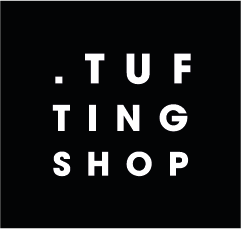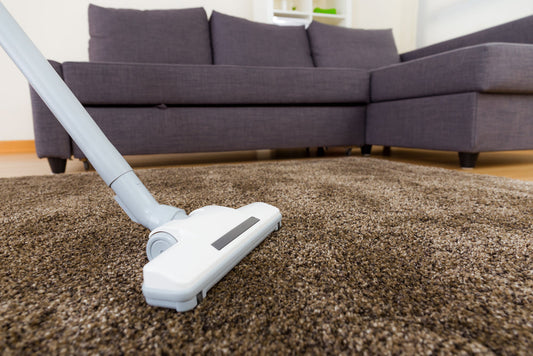
Getting started
Share
Overview
Here's a detailed table of contents to help you navigate through the comprehensive guide on tufting:
- Welcome and Introduction
- Tufting 101: The Basics
- Getting Started: What You'll Need
- Design Approaches
- The Cost of Tufting
- Community and Creativity
- Tufting Gun Know-How
- Alternatives to Tufting Guns
- Wrapping It Up
Welcome and Introduction
Welcome to our cozy little WIKI corner! Here, you'll find answers to all your tufting questions. We keep updating this space with fresh info, so it's like a living, breathing guide. Got a question? Chances are, you'll find the answer here. And hey, we're all part of the Reddit tufting community, so let's learn together!
 Tufting 101: The Basics
Tufting 101: The Basics
What is Tufting?
Tufting is like the cool cousin of traditional carpet making. Tufting is a modern technique in textile art that involves using a specialized tool called a tufting gun. This tool helps to weave yarn into a base fabric, creating intricate and textured designs. Unlike traditional carpet making, which can be time-consuming and labor-intensive, tufting allows for faster and more flexible creation of various textile projects. With tufting, you can produce a range of items, from cozy, custom-designed rugs to vibrant, detailed wall art pieces. The process involves pushing yarn through a fabric that's stretched over a frame, enabling artists to experiment with different textures, patterns, and colors to bring their creative visions to life.

Getting Started: What You'll Need
What Do I Need to Start Tufting?
- Tufting gun: The primary tool for tufting.
- Frame: To hold your fabric taut.
- Fabric: Primary material to tuft on.
- Yarn: The creative material to make your designs.
Where Can I Find Tufting Guns?
Check out our comparison tables for a rundown on different tufting guns.
https://tuftingshop.com/pages/tufting-gun-comparison-table
What Yarn Can I Use?
Most yarns work, but wool is a champ for rugs. For a deeper dive, navigate to our yarn wiki.

Design Approaches
How Do I Get My Design Onto My Fabric?
You've got two main options: drawing directly on the fabric or using a projector or tracing paper. Just remember, you'll be working from the back, so plan accordingly, by mirroring the image!

The Cost of Tufting
Tufting isn't free, but it doesn't have to break the bank. Costs vary based on material quality and project size.
Yarn: Wool is more expensive but offers superior quality and durability. It's a natural, eco-friendly choice, perfect for high-quality rugs and art pieces.
Tufting Gun: A high-quality tufting gun is a one-time investment. Though initially pricey, it ensures durability and consistent performance, saving you money in the long run.
Other Costs: Additional expenses include the frame, fabric, and finishing tools. While the initial setup may be costly, many items are reusable for future projects.
Investing in quality materials and tools pays off with beautiful, long-lasting results.
Community and Creativity
We're all in this tufting journey together. The community is still growing, and there's so much creativity and innovation happening. So don't hesitate to reach out and share!
Tufting Gun Know-How
Loop Pile vs. Cut Pile
Loop pile creates bumps, while cut pile gives you a smooth surface. Both have their perks! But it's mostly a personal preference and a lot of fun to combine the effects. In the image below, the eyes and mouth are loop pile, the rest cut pile.

Using a Tufting Gun
Step-by-Step Tufting Process:
-
Stretch the Cloth:
- Secure your fabric (monk's cloth or primary backing fabric) tightly over the frame. Ensure it is taut to prevent any slack that could affect the tufting process.
-
Thread the Machine:
- Thread your tufting gun with the yarn. Follow the manufacturer's instructions to ensure the yarn is properly fed through the machine.
-
Start Tufting:
- Begin by tufting straight lines. This helps you get accustomed to the machine and ensures an even foundation for more complex designs.
- Consistent pressure is key. Apply steady pressure to ensure the yarn penetrates the fabric evenly.
- Make sure your frame is stable to prevent any movement that could disrupt your lines.
-
Direction and Consistency:
- Follow the direction you want to go with your design. Consistency in your movements will result in a more uniform and professional-looking finish.
- Keep a steady pace and avoid sudden changes in direction or speed, which can create uneven loops or piles.
Maintenance Tips
Keep your gun lubricated and your workspace clean. If something sounds off, stop and check. Lubricate with sewing machine oilby applying it on the reels. If the machine beeps, it's usually because of a blockage.
Wrapping It Up
Tufting is a fantastic way to express yourself creatively. Whether you're a pro or a newbie, there's always something new to learn. So dive in, have fun, and let's make some awesome stuff together!







